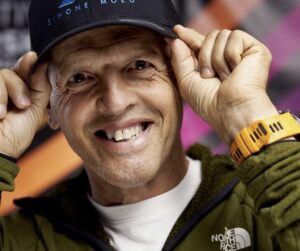Is climbing history in the making or another Into Thin Air? At the end of a year like no other, K2 will see a winter like no other.
Less than 30 people have ever stood on the top of an 8,000m peak in winter, but none on K2. It is the only 8,000’er left unclimbed in winter. Yet more than 70 climbers are currently flocking to the so-called Savage Mountain. Among them, only one knows how cold and hostile it can be at 8,000m in the winter Karakorum. Only two others have attempted K2 in this season before. The aspirants are grouped into (so far) four teams, and one of them is a commercial expedition.
Unsurprisingly, the possibility of this tantalizing first has seized the attention of the worldwide mountaineering community. Speculation has soared — about the personalities, how pure a style they will choose, the magnitude of the challenge. The overall picture here differs greatly from the first winter ascents of the other 13 8,000m peaks. This has an almost theatrical flavor.
A disaster in the making?
It’s something not seen since Everest 1996. Back then, two commercial expeditions vied for the highest number of clients on top. Very different personalities clashed in their pursuit of glory, and disaster struck on summit day. Of course, no one wants such tragedy this time, but the elements leading up to this K2 season do produce a sense of deja vu.

Been there, done that: Adam Bieleki summited Gasherbrum I in 2012, above, and attempted Winter K2 in 2017. He hopes that the first climbers to achieve this first will do so without O2. Simone Moro recently said it would be only fair for Polish climbers to finish the Winter K2 project they started.
“That high a number [of climbers] reflects the size of the human ambition to become part of [mountaineering] history,” Simone Moro said in a recent interview. But he added that ambition will not be enough, without commensurate experience, skills, and most of all, “the right team”.
But rather than than one or two well-oiled teams, K2 will host a heterogeneous group of people, driven by a grab bag of motives, from fame to commercial interests.

Seven Summit Treks’ lead Sherpa team in Askole, December 16.
Central to this drama is Nepal-based Seven Summit Treks, which has rapidly grown from a local operator to possibly the largest outfitter for Himalayan expeditions. They have shown a remarkable capacity to find creative solutions. No doubt hurting like every other tourism company in the world, they are surely trying to salvage something from an otherwise disastrous year. When Pakistan became willing to accept foreign climbers, SST put together a grand adventure in record time.
Buy into history
And what an adventure: for about $35,000, according to ExWeb sources, you have a chance to hep crack the ultimate unsolved problem in the Himalaya. The fully serviced venture features plenty of O2, a rope-fixing team prepping every step of the way, as much comfort as possible in Base Camp, highly experienced Sherpa guides, and professional climbers Arnold Coster and Sergi Mingote, coordinating and overseeing progress.
A significant number of climbers have already signed on. Although all have summited several 8,000m peaks before, their skill level varies. Some have always been guided, while others have climbed in small, independent groups without no-O2. All are about to embark on a new experience involving a significant risk.
Winter K2 is not Everest –- not even winter Everest. Alex Txikon has pointed out that sunny days are common at Everest in winter, but not at K2. Last January, he built igloos at K2 BC, which he did not need to do at Everest at the same time of year.
A windy day at K2 Base Camp lat January, filmed by Alex Txikon. Check this cool interactive map for the whole route by Txikon/RaceTracker.
There’s a reason why K2 has not been climbed in winter
Winter veterans are skeptical about how long non-professional climbers can endure K2 Base Camp in January. “Most of these clients will get to BC,” Moro notes, “spend one or two weeks there, suffering like crazy, then run back home, with the entire fee paid but only five percent of the services used. From a business point of view, it’s really smart, while not so good for the history of alpinism.”
And while all are climbers, how cohesive will they be as a team? Some have climbed together regularly in the past, while others are simply relying on their own on-site judgment and the endurance of their personal Sherpa.
Such is the case of Poland’s Magdalena Gorzkowska. In an interview with RMF24, the former track athlete stated that she knows no one in the team and will climb based on her level of comfort. “We’re an international team only at Base Camp,” she said. “Higher up, everyone works alone and makes their own decisions.”

Magdalena Gorzkowska illustrates her transition from track to mountaineering. Photo: Magdalena Gorzkowska
Gorzkowska acquired experience on Everest (with O2) and Makalu (no O2) and trusts in her strength as a athlete. On K2, she will climb with both two personal Sherpas and cinematographer Oswald Rodrigo Pereira, who has often filmed for the Polish Himalayan Winter Team.

Wrapped in adjectives like “deadly” and “impossible”, Winter K2 is garnering attention for expedition members even before they set foot in Pakistan. Above, Antonios Sykaris on Greek TV.
Winter veteran Jacek Teler foresees trouble when climbers rotate for acclimatization between BC and higher camps, because of lack of space, especially at Advanced Base Camp and Camp 1 below the House Chimney, which can squeeze in just a couple of tents.

Camp1 is far from comfortable, even in summer, above. Photo: Mike Horn
If previous attempts on Winter K2 have taught anything, it’s the damage done by poor communication between climbers, clashing egos and lack of collaboration. Every recent expedition there has grappled with controversy or quarrel: the Polish team and Denis Urubko in 2017, the harsh exchanges between Alex Txikon’s and Vasiliy Pivtsov’s teams in 2018, and Tomaz Rotar and John Snorri’s criticism of leader Mingma Gielje, aka Mingma G, when they joined his first commercial expedition to attempt winter K2 last year.

John Snorri, last week at Base Camp. Photo: John Snorri
A history of conflict
This winter, Mingma G and Snorri are back to K2 on separate expeditions. Snorri has hired two “high-altitude porters” who happen to be Muhammad Ali Sadpara, Pakistan’s most renowned high-altitude climber, and his son Sajid. Sadpara the elder already has the first winter ascent of Nanga Parbat under his belt.
Mingma G was also burned by last year’s bitter experience, so instead of clients, this year he is climbing with two strong Sherpa colleagues. Mingma has vehemently dismissed past controversies, claiming that he is willing to collaborate with everyone else on the mountain and blaming the media for suggesting an atmosphere of competition.
Finally, all-star Nirmal Purja has announced he will attend the K2 gathering as well, but as usual, he provides no details. Will he be part of the SST expedition, climb independently, or lead his own clients? No one knows.
But the fact remains that there is a competition for the first winter ascent of K2. This is what is driving so many to embrace the questionable joy of climbing at -30ºC.
For now, the question is not who’ll get to the top, but rather, how far will they get? And will everyone escape safely from K2 when it shows its true colors?
The 39-minute documentary below on the Polish attempt on Winter K2 three years ago lays out some of the potential difficulties, even for these masters of winter.






